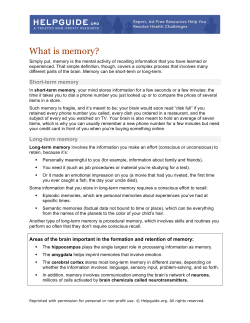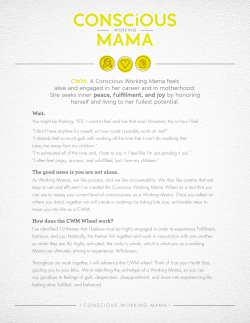
Guest Column
Guest Column 7 Tips on How to Stay Steady and Make Change Stick By Dr. Joe Dispenza, Leading Brain/Change Expert and International Bestselling Author of Breaking the Habit of Being Yourself: How to Lose Your Mind and Create a New One It’s now March…have you been able to fulfill your New Year’s resolutons? Contrary to what you might think after having set out to keep your New Year’s Resolutions in the past, only to see them dissolve in frustration and failure, the brain is the organ of change. The concept in neuroscience called neuroplasticity demonstrates that the brain alters itself every time we learn something new. Our nerve cells are specially arranged by what we learn, what we remember, what we experience, what we feel and what we envision. Our 100 billion brain cells are always communicating with the rest of our anatomy. If you learn even one new bit of information today, tiny brain cells will make new connections within the living lattice work of your system. In other words, when we really change our mind, the brain changes…and then we can effect permanent, lasting change. Not more than thirty or forty years ago, there was a unanimous belief in biology that the brain was hardwired, meaning that we are born with a certain amount of neurological connections and the finality in life was that we were going to turn out like our parents. But with the advent of the latest technologies in functional imagery it is apparent that it is very possible to make the brain work differently. In fact, research out of the University of Wisconsin has proven something as simple as attention or focused concentration is a skill just like golf or tennis. In other words, the more you practice being mindful the better you get at it. In addition, functional imagery has clearly proven that we can also change the brain just by thinking differently. For example, people that never played the piano were divided into groups. The first group physically played one-handed finger exercises like scales and chords, and as a result of the new activity, their brains changed. The before and after results of the functional brain scans showed new areas of the brain activated. In essence, not only did they make a new mind, literally new brain circuits flourished. However, when a second group was asked to mentally rehearse the same scales and chords in their mind for the same amount of time, they grew the same amount of brain connections as the group who physically demonstrated the activity. Simply put, when we are truly focused and attentive, the brain does not know the difference between what is happening in our mind’s eye and what is happening in the external world. So, when you take the time out of your busy schedule and begin to intentionally dream a new reality, focusing on your goal of losing weight, quitting smoking, exercising daily—for example-just remember that your brain is rewiring itself to your desires and your body is being reconditioned in order to prepare itself for that new event. Therefore, if you mentally rehearse daily what it would be like to experience any transformation, there will be internal changes taking place that will begin to help you achieve your goal. So if you want to Make Change Stick, here are seven initial steps to start you on the path. 1) INTENTION, INTENTION, INTENTION! Write a clear and simple resolution statement. This tells your brain that you mean it. Make sure your mission statement creates a positive feeling for you. Avoid words such as not and don't. Make your resolution specific. Instead of saying you want to eat healthier, say, "I will eat a fresh healthy salad once a day so that I look better and feel better about myself." Your intention is your mental compass. The clearer your purpose, the better you know where you are going and how you will get there. 2) SPONSORING THOUGHTS! List strong reasons about why you want to change. This is the biggest secret to making change stick. You should feel passionate about each one of these thoughts. Be specific. For example, if you are interested in losing weight, one reason could be to wear your mother’s wedding dress for your wedding ceremony in five months. If intention gives you your direction, then your sponsoring thoughts are the fuel to get you going each day in your direction. 3) REVIEW, REMIND AND PRIME! Create a plan. Then review your actions steps daily. To get yourself in the right state of mind, review your specific behaviors for the day when you wake up in the morning and/or before you go to bed in the evening. This little exercise literally sets up your day so that you stay conscious of your change. If you imagine yourself making the necessary decisions for that day, you will begin to prime your brain to automatically follow your intentions. Your mental rehearsal can install the neurological hardware and software so that you have the circuits in place to use when executing your changes appropriately. For instance, questions like: “What do I have to do to get there?” Write down the steps. “When do I need to have those steps taken?” Decide what steps you can take this day or even right now. Review and remind yourself of the entire plan and then take the first step. Think of this as reviewing your map on your journey to change. The more you do it the easier it is to get to your destination. 4) ALIGN YOUR BEHAVIOR TO MATCH YOUR INTENTION! Hold yourself accountable by demonstrating change in your entire day. One of the hardest parts of breaking a habit is to not make the same choices you made days, weeks or months prior. When you decide what you are not going to do that day, it will help keep you on task. The biggest reason most people fall short of their vision relates to giving into familiar feelings. Get clear that when those feelings, cravings and bodily urges come up during your day that drive your devilish thoughts to concede, that you have the will to conquer them. This is when you take your ‘new you’ for a test drive. Your daily goals will always be in alignment with your ongoing intention. Think of this step as small destinations or towns you arrive at along your journey. 5) TRACK YOUR CHANGES! Create a reward system for yourself. If you can create a chart that you can see or a ledger you review daily and then check your wins off daily, you will begin to make your discipline and changes a new habit….and build a new feeling of self-esteem, worth and belief that you are doing it. If however, you fall from grace one day, make the choice to get back into your routine the very next day without wallowing in failure, guilt and self-depreciation. These emotions will surely undermine your efforts and cause you to return to the old self that may have already felt that way for too long. It’s always good to see how far you have come and how you are doing. 6) COME OUT OF YOUR RESTING STATE: CHANGE YOUR ENERGY Change can be uncomfortable. When we are in the midst of change, it feels unnatural, unfamiliar and uncertain because we are no longer ‘being’ the same person. You are in the unknown. We are changing how we think, how we act and how we feel. Therefore, each day when you begin you must lift yourself into a new state of being and raise your energy. Questions like: “How would I have to ‘be’ today to master my day?” “How would I feel in my future when I am this person?” These are key ingredients. I like to say, “I cannot get up today as the same person who sat down, I must be in a new state of being and live from this level of energy.” Get excited that you can conquer yourself in some way. 7) CUE YOUR ENVIRONMENT There is nothing more satisfying than to have little reminders in your life to keep you on track. Place pictures, notes, word phrases, and/or vision boards where you can see them daily, such as at your desk, on the refrigerator or pasted to the bathroom mirror. You can even play certain motivational CD’s in your car, or MP3 files while you exercise or inspirational music. These will keep you on task by reminding you that what you are doing is important. The more you stay conscious of your future, the more inspired you will be to overcome your present reality. These are but a few starter steps. There is much more that can be done to ensure that you can Make Change Stick. But simply know that it is possible to change. True transformation is possible—and it is possible for YOU! Dr. Joe Dispenza is known as one the world’s most prominent brain/change experts and author of the international bestselling books Breaking the Habit of Being Yourself: How to Lose Your Mind and Create a New One, and Evolve Your Brain: The Science of Changing Your Mind. He was also one of the featured researchers in What the BLEEP Do We Know!? You can find Dr. Dizpenza’s Making Change Stick course online on his website. For more information on Dr. Dispenza, his events and his books, go to www.drjoedispenza.com. ____________________________________________________________________ Would you like to reprint Conscious Creation articles? We would be pleased to have you help spread this vital information as long as you include the following signature at the end: Jackie Lapin is the world leader in educating, mentoring and coaching people on Practical Conscious Creation. She is the bestselling author of "The Art of Conscious Creation; How You Can Transform the World" and "Practical Conscious Creation: Daily Techniques to Manifest Your Desires." Filled with specific and imaginative practices, Practical Conscious Creation offers 70 articles with step-by-step actions to achieve greater empowerment and a more satisfying lifestyle. To learn how to become a better, faster manifestor, secure a free chapter of "Practical Conscious Creation" or receive Jackie Lapin's daily manifesting tips, visit www.jackielapin.com.
© Copyright 2025





















